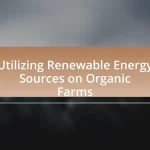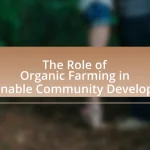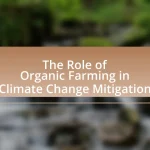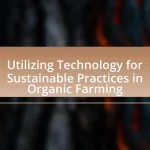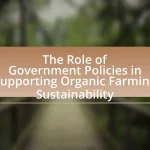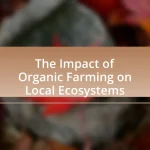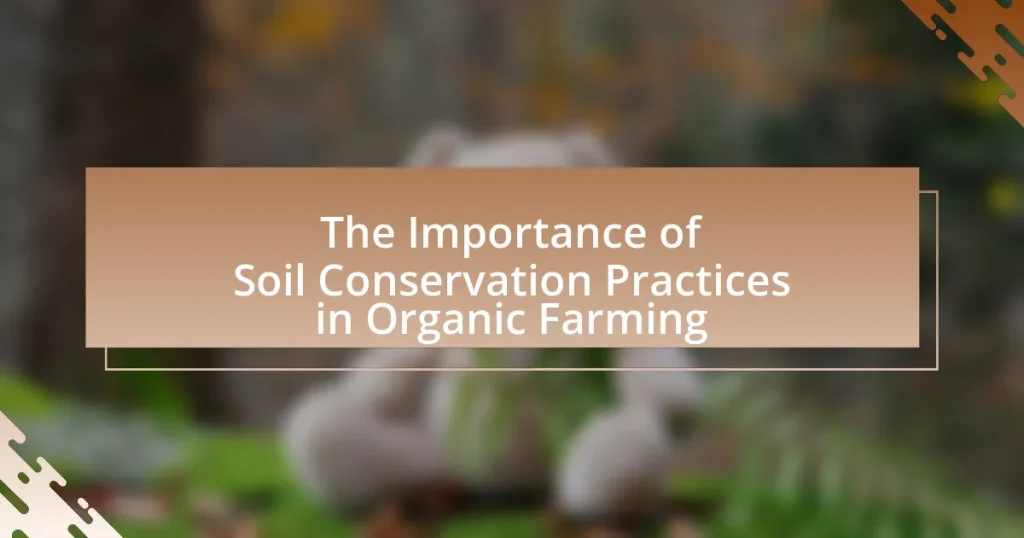Soil conservation practices are essential components of organic farming, encompassing techniques such as crop rotation, cover cropping, reduced tillage, and the use of organic amendments. These practices enhance soil health, prevent erosion, and improve water retention, ultimately leading to increased crop yields and biodiversity. Research indicates that implementing these methods can significantly boost soil organic matter and productivity while mitigating climate change effects and improving water quality. The article explores the various soil conservation practices, their economic advantages, challenges faced by farmers, and future trends in sustainable agriculture, highlighting the critical role of soil health in organic farming systems.
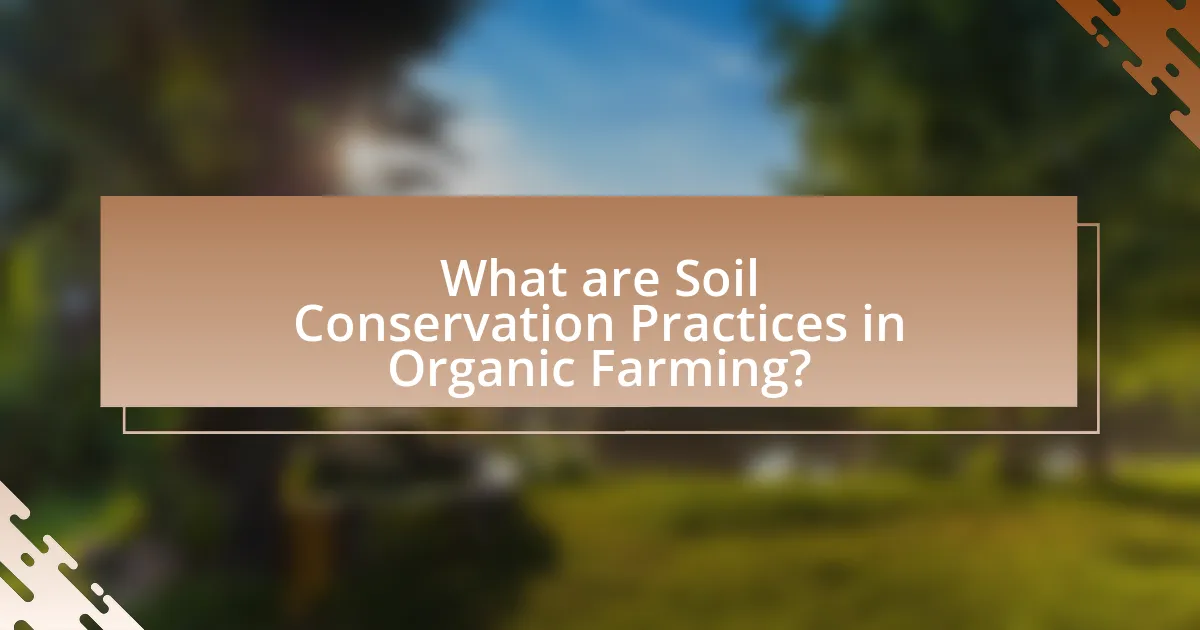
What are Soil Conservation Practices in Organic Farming?
Soil conservation practices in organic farming include techniques such as crop rotation, cover cropping, reduced tillage, and the use of organic amendments. These practices enhance soil health, prevent erosion, and improve water retention. For instance, crop rotation disrupts pest cycles and enhances nutrient availability, while cover crops protect the soil from erosion and improve organic matter content. Research indicates that these methods can lead to a 30% increase in soil organic matter over time, demonstrating their effectiveness in maintaining soil integrity and fertility.
Why are Soil Conservation Practices essential in Organic Farming?
Soil conservation practices are essential in organic farming because they enhance soil health, prevent erosion, and promote biodiversity. Healthy soil is crucial for organic farming as it supports plant growth, retains moisture, and provides essential nutrients. Practices such as cover cropping, crop rotation, and reduced tillage help maintain soil structure and fertility, which are vital for sustainable agricultural systems. Research indicates that implementing these practices can increase soil organic matter by up to 30%, significantly improving soil quality and productivity over time.
What role does soil health play in organic farming sustainability?
Soil health is crucial for organic farming sustainability as it directly influences crop productivity, biodiversity, and ecosystem resilience. Healthy soil enhances nutrient availability, improves water retention, and supports beneficial microbial communities, which are essential for organic farming practices. Research indicates that organic farming systems that prioritize soil health can yield comparable or even higher outputs than conventional systems while maintaining environmental integrity. For instance, a study published in the journal “Agriculture, Ecosystems & Environment” by Reganold and Wachter (2016) found that organic farms with healthy soils had 30% higher yields in certain crops compared to conventional farms, demonstrating the vital link between soil health and sustainable agricultural practices.
How do soil conservation practices impact crop yield in organic farming?
Soil conservation practices significantly enhance crop yield in organic farming by improving soil health and fertility. These practices, such as cover cropping, reduced tillage, and crop rotation, help maintain soil structure, increase organic matter, and promote beneficial microbial activity. Research indicates that farms employing these methods can experience yield increases of 10-30% compared to conventional practices, as healthier soils retain moisture and nutrients more effectively. For instance, a study published in the journal “Agriculture, Ecosystems & Environment” by Reganold and Wachter (2016) found that organic farms utilizing soil conservation techniques had higher yields and better resilience to climate variability.
What types of Soil Conservation Practices are commonly used in Organic Farming?
Soil conservation practices commonly used in organic farming include cover cropping, crop rotation, reduced tillage, and the use of organic amendments. Cover cropping involves planting specific crops to protect and enrich the soil, which helps prevent erosion and improves soil structure. Crop rotation enhances soil fertility and disrupts pest cycles by alternating different types of crops in a given area. Reduced tillage minimizes soil disturbance, preserving soil structure and microbial life, while organic amendments, such as compost and manure, enhance soil nutrient content and biological activity. These practices collectively contribute to sustainable soil health and productivity in organic farming systems.
What is cover cropping and how does it benefit soil conservation?
Cover cropping is the agricultural practice of planting specific crops primarily to improve soil health and prevent erosion. This method benefits soil conservation by enhancing soil structure, increasing organic matter, and reducing nutrient runoff. Research indicates that cover crops can reduce soil erosion by up to 90% compared to bare soil, as they provide ground cover that protects against wind and water erosion. Additionally, cover crops improve soil fertility by fixing nitrogen and increasing microbial activity, which contributes to a healthier soil ecosystem.
How does crop rotation contribute to soil health in organic farming?
Crop rotation significantly enhances soil health in organic farming by improving soil structure, nutrient availability, and biodiversity. This practice involves alternating different crops in a specific sequence over time, which helps prevent soil depletion and reduces pest and disease cycles. For instance, legumes, when included in the rotation, fix nitrogen in the soil, enriching it for subsequent crops. Research indicates that crop rotation can increase soil organic matter and microbial activity, leading to improved soil fertility and resilience. A study published in the journal “Agronomy for Sustainable Development” found that diverse crop rotations can enhance soil health indicators, demonstrating the effectiveness of this practice in maintaining sustainable agricultural systems.
What challenges do farmers face in implementing Soil Conservation Practices?
Farmers face several challenges in implementing Soil Conservation Practices, including financial constraints, lack of knowledge, and limited access to resources. Financial constraints often hinder farmers from investing in necessary equipment and materials for effective soil conservation. A study by the Food and Agriculture Organization (FAO) indicates that many farmers lack the capital to adopt new practices, which can lead to soil degradation over time. Additionally, a lack of knowledge about the benefits and techniques of soil conservation can prevent farmers from making informed decisions. Research from the International Soil Conservation Organization highlights that education and training programs are essential for improving farmers’ understanding of these practices. Lastly, limited access to resources such as quality seeds, organic fertilizers, and technical support can impede the successful implementation of soil conservation strategies, as noted in various agricultural extension reports.
How do economic factors influence the adoption of soil conservation techniques?
Economic factors significantly influence the adoption of soil conservation techniques by affecting farmers’ financial capacity and perceived benefits. When farmers face high costs for implementing conservation practices, such as cover cropping or reduced tillage, they may be less likely to adopt these methods unless they see a clear economic advantage, such as increased crop yields or reduced input costs. Research indicates that farmers are more inclined to adopt soil conservation techniques when they receive financial incentives or subsidies, which can offset initial investment costs. For instance, a study published in the Journal of Soil and Water Conservation found that financial assistance programs increased the adoption rates of conservation practices by up to 30% among participating farmers. Thus, economic factors play a crucial role in determining whether farmers will invest in soil conservation techniques, as they weigh the costs against potential long-term benefits.
What are the common misconceptions about soil conservation in organic farming?
Common misconceptions about soil conservation in organic farming include the belief that organic practices do not require soil management, that organic farming leads to soil degradation, and that organic fertilizers are less effective than synthetic ones. Organic farming emphasizes soil health through practices like crop rotation, cover cropping, and reduced tillage, which enhance soil structure and fertility. Research indicates that organic farming can improve soil organic matter and biodiversity, countering the notion that it depletes soil quality. Additionally, studies show that organic fertilizers, such as compost and manure, can be equally effective in providing nutrients compared to synthetic options, supporting sustainable soil conservation.
How can farmers effectively implement Soil Conservation Practices?
Farmers can effectively implement soil conservation practices by adopting techniques such as crop rotation, cover cropping, and reduced tillage. Crop rotation enhances soil fertility and disrupts pest cycles, while cover cropping prevents soil erosion and improves organic matter. Reduced tillage minimizes soil disturbance, preserving soil structure and moisture. Research indicates that these practices can increase soil health and productivity; for instance, a study published in the Journal of Soil and Water Conservation found that cover crops can reduce soil erosion by up to 90% compared to bare soil.
What are the best practices for integrating soil conservation into organic farming systems?
The best practices for integrating soil conservation into organic farming systems include implementing cover cropping, practicing crop rotation, utilizing reduced tillage, and applying organic amendments. Cover cropping enhances soil structure and prevents erosion by maintaining ground cover during off-seasons. Crop rotation disrupts pest cycles and improves soil fertility by alternating deep and shallow rooting plants. Reduced tillage minimizes soil disturbance, preserving soil organic matter and microbial communities. Organic amendments, such as compost and green manures, enrich soil nutrients and enhance its water retention capacity. These practices collectively contribute to sustainable soil health, as evidenced by studies showing improved soil quality and increased crop yields in organic systems.
How can technology aid in soil conservation efforts for organic farmers?
Technology aids in soil conservation efforts for organic farmers by providing tools and methods that enhance soil health and reduce erosion. Precision agriculture technologies, such as soil sensors and drones, allow farmers to monitor soil moisture, nutrient levels, and organic matter content in real-time, enabling them to make informed decisions about crop management. For instance, the use of GPS-guided equipment helps in minimizing soil compaction and optimizing planting patterns, which can lead to improved soil structure and fertility. Additionally, data analytics can help farmers implement cover cropping and crop rotation strategies more effectively, which are essential practices for maintaining soil integrity. Research indicates that these technologies can increase soil organic carbon levels, thereby enhancing soil resilience and productivity over time.
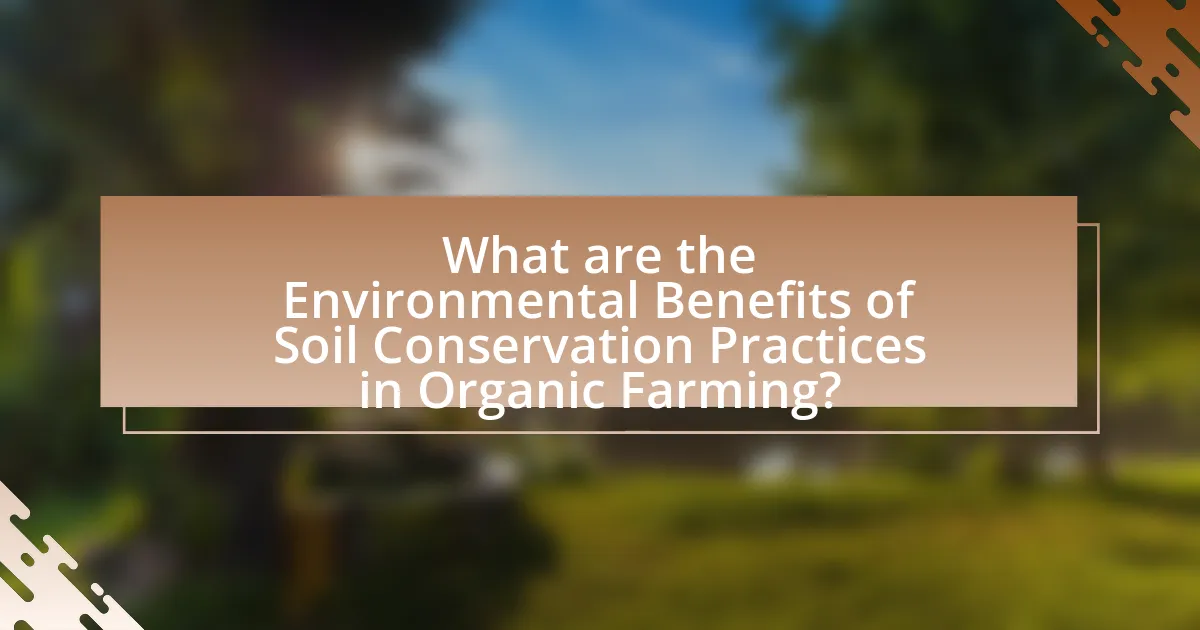
What are the Environmental Benefits of Soil Conservation Practices in Organic Farming?
Soil conservation practices in organic farming provide significant environmental benefits, including enhanced soil health, improved water retention, and increased biodiversity. These practices, such as crop rotation, cover cropping, and reduced tillage, contribute to the prevention of soil erosion and degradation. For instance, a study published in the journal “Agriculture, Ecosystems & Environment” found that cover crops can reduce soil erosion by up to 90% compared to conventional farming methods. Additionally, organic farming practices promote the presence of beneficial microorganisms and organic matter, which improve soil structure and fertility. This leads to better water infiltration and retention, reducing the need for irrigation and minimizing runoff, which can pollute waterways. Overall, soil conservation practices in organic farming play a crucial role in sustaining environmental health and promoting ecological balance.
How do Soil Conservation Practices enhance biodiversity?
Soil conservation practices enhance biodiversity by improving soil health, which supports a wider variety of organisms. Healthy soils, maintained through practices such as cover cropping, reduced tillage, and organic amendments, provide essential nutrients and habitat for diverse microbial communities, insects, and plants. Research indicates that these practices can increase soil organic matter, which is crucial for sustaining diverse life forms. For example, a study published in the journal “Agriculture, Ecosystems & Environment” found that farms employing soil conservation techniques had up to 30% more species richness compared to conventional farms. This increase in biodiversity contributes to ecosystem resilience, pest regulation, and nutrient cycling, ultimately benefiting organic farming systems.
What is the relationship between soil conservation and water quality?
Soil conservation directly enhances water quality by reducing erosion and preventing sedimentation in water bodies. When soil is conserved through practices such as cover cropping and reduced tillage, it maintains its structure and organic matter, which helps absorb and filter rainwater. This process minimizes runoff, which can carry pollutants like fertilizers and pesticides into streams and rivers. Studies indicate that effective soil conservation practices can lead to a significant decrease in nutrient runoff, thereby improving the overall quality of water in agricultural regions. For instance, research published in the Journal of Environmental Quality found that implementing soil conservation measures reduced nitrogen and phosphorus runoff by up to 50%, demonstrating a clear link between soil health and water quality.
How do these practices mitigate climate change effects?
Soil conservation practices in organic farming mitigate climate change effects by enhancing soil health, increasing carbon sequestration, and reducing greenhouse gas emissions. These practices, such as cover cropping, reduced tillage, and organic amendments, improve soil structure and fertility, which leads to greater organic matter retention. For instance, studies show that cover crops can sequester up to 1.5 tons of carbon per hectare annually, effectively lowering atmospheric CO2 levels. Additionally, reduced tillage minimizes soil disturbance, which decreases the release of stored carbon and enhances soil’s ability to retain moisture, thereby improving resilience to climate variability.
What economic advantages do Soil Conservation Practices provide to Organic Farmers?
Soil conservation practices provide economic advantages to organic farmers by enhancing soil fertility and reducing input costs. These practices, such as cover cropping and reduced tillage, improve soil structure and health, leading to increased crop yields. For instance, a study published in the journal “Agriculture, Ecosystems & Environment” found that implementing cover crops can increase yields by 10-20%, which directly translates to higher revenue for farmers. Additionally, healthier soils require fewer chemical fertilizers and pesticides, resulting in lower operational costs. This combination of increased productivity and reduced expenses contributes to the overall economic viability of organic farming.
How can soil conservation lead to cost savings in organic farming?
Soil conservation can lead to cost savings in organic farming by enhancing soil health and reducing the need for external inputs. Healthy soil improves water retention and nutrient availability, which decreases reliance on fertilizers and irrigation. For instance, practices such as cover cropping and reduced tillage can increase organic matter in the soil, leading to better crop yields without additional costs. Research indicates that farms implementing soil conservation practices can save up to 30% on input costs over time, as demonstrated in a study by the USDA, which found that sustainable practices significantly lower expenses related to soil degradation and fertility management.
What is the long-term financial impact of investing in soil health?
Investing in soil health leads to significant long-term financial benefits for farmers and agricultural systems. Improved soil health enhances crop yields, reduces input costs, and increases resilience to climate variability. For instance, a study published in the journal “Agricultural Systems” found that practices enhancing soil health can increase yields by 20-30% over time, translating to higher revenue for farmers. Additionally, healthier soils require fewer chemical fertilizers and pesticides, which lowers operational costs. According to the USDA, investing in soil conservation practices can yield a return on investment of up to $3 for every $1 spent, demonstrating the financial viability of prioritizing soil health in organic farming.
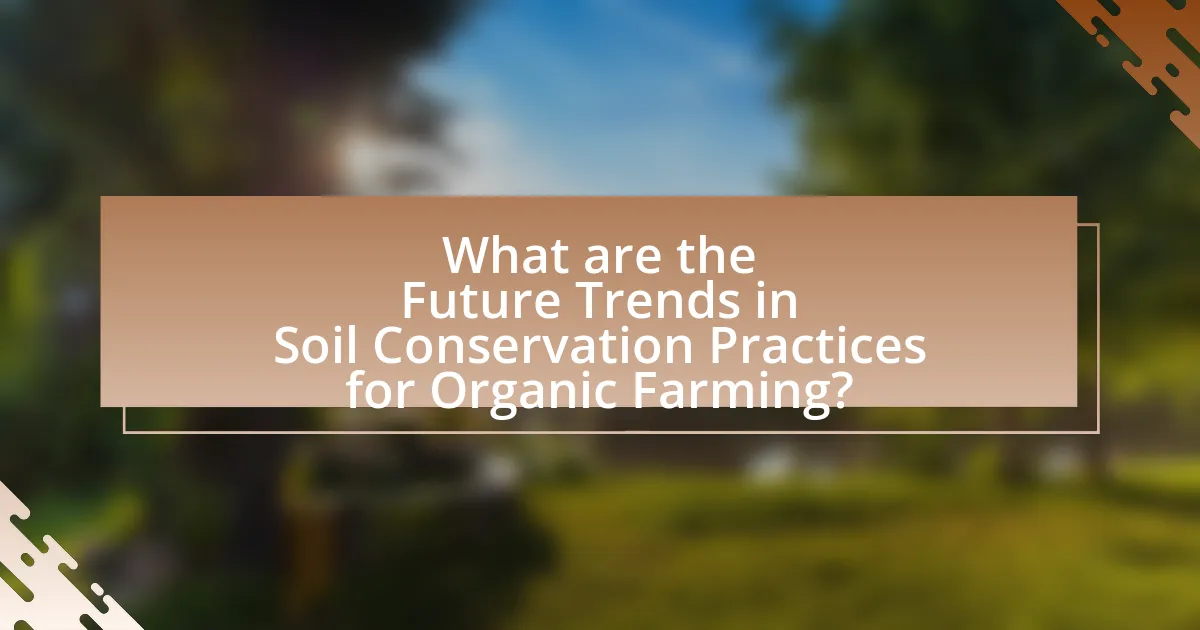
What are the Future Trends in Soil Conservation Practices for Organic Farming?
Future trends in soil conservation practices for organic farming include the increased use of cover cropping, agroecological approaches, and precision agriculture technologies. Cover cropping enhances soil health by preventing erosion, improving nutrient cycling, and increasing organic matter, which is supported by studies showing that cover crops can increase soil organic carbon levels by up to 1.5 tons per hectare annually. Agroecological practices, such as crop rotation and intercropping, promote biodiversity and resilience in farming systems, with research indicating that diverse cropping systems can reduce pest pressures and improve yields. Additionally, precision agriculture technologies, including soil sensors and data analytics, enable farmers to optimize inputs and manage soil health more effectively, leading to improved sustainability and productivity in organic farming.
How is research shaping the future of soil conservation in organic agriculture?
Research is significantly shaping the future of soil conservation in organic agriculture by developing innovative practices and technologies that enhance soil health and sustainability. For instance, studies have shown that cover cropping and crop rotation improve soil structure and fertility, which are essential for organic farming. Research published in the journal “Agriculture, Ecosystems & Environment” by authors such as Teasdale et al. (2019) demonstrates that these practices can reduce erosion and increase organic matter content in the soil. Additionally, advancements in soil microbiome research are revealing how beneficial microorganisms can be harnessed to promote nutrient cycling and disease resistance, further supporting the goals of organic agriculture. These findings underscore the critical role of ongoing research in informing effective soil conservation strategies that align with organic farming principles.
What innovative practices are emerging in soil conservation?
Innovative practices emerging in soil conservation include regenerative agriculture, cover cropping, and agroforestry. Regenerative agriculture focuses on restoring soil health through techniques such as no-till farming and crop rotation, which enhance soil structure and biodiversity. Cover cropping involves planting specific crops during off-seasons to prevent soil erosion and improve nutrient cycling. Agroforestry integrates trees and shrubs into agricultural landscapes, promoting soil stability and enhancing carbon sequestration. These practices are supported by research indicating that regenerative methods can increase soil organic matter by up to 1% per year, significantly improving soil fertility and resilience.
How can policy changes support soil conservation efforts in organic farming?
Policy changes can support soil conservation efforts in organic farming by providing financial incentives and regulatory frameworks that promote sustainable practices. For instance, implementing subsidies for organic farmers who adopt cover cropping and reduced tillage can enhance soil health and biodiversity. Research indicates that practices like these can improve soil structure and fertility, leading to increased crop yields and resilience against erosion. Additionally, policies that mandate soil health assessments and promote education on best practices can further empower farmers to implement effective soil conservation strategies.
What practical steps can farmers take to enhance Soil Conservation Practices?
Farmers can enhance soil conservation practices by implementing crop rotation, cover cropping, and reduced tillage. Crop rotation improves soil structure and fertility by alternating different crops, which helps break pest and disease cycles. Cover cropping, such as planting legumes, adds organic matter and nutrients to the soil while preventing erosion. Reduced tillage minimizes soil disturbance, preserving soil structure and microbial life, which are essential for healthy soil ecosystems. Research indicates that these practices can significantly improve soil health and productivity, as demonstrated in studies showing increased yields and reduced erosion rates in fields utilizing these methods.
What resources are available for farmers to learn about soil conservation techniques?
Farmers can access various resources to learn about soil conservation techniques, including government agricultural extension services, online courses, and agricultural research institutions. For instance, the USDA Natural Resources Conservation Service provides educational materials and technical assistance focused on soil health practices. Additionally, universities often offer workshops and publications on soil management, such as the University of California’s Agriculture and Natural Resources program, which emphasizes sustainable practices. Non-profit organizations like the Soil Conservation Society also provide resources, including guides and webinars, to promote effective soil conservation strategies.
How can farmers measure the effectiveness of their soil conservation efforts?
Farmers can measure the effectiveness of their soil conservation efforts by assessing soil health indicators such as organic matter content, soil erosion rates, and crop yield improvements. Soil health indicators provide quantifiable data; for instance, an increase in organic matter can enhance soil structure and water retention, leading to better crop performance. Research shows that practices like cover cropping and reduced tillage can reduce soil erosion by up to 90%, demonstrating significant conservation effectiveness. Additionally, monitoring changes in crop yields over time can provide direct evidence of improved soil conditions resulting from conservation practices.
